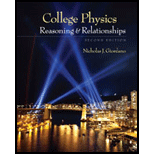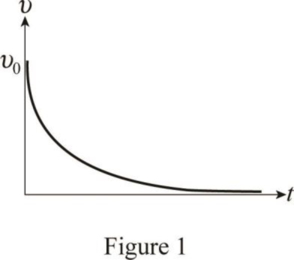
College Physics
2nd Edition
ISBN: 9780840058195
Author: Giordano, Nicholas J.
Publisher: Cengage Learning
expand_more
expand_more
format_list_bulleted
Concept explainers
Question
Chapter 2, Problem 1Q
To determine
Sketch a velocity-time graph with negative acceleration and give an example for such a motion.
Expert Solution & Answer
Answer to Problem 1Q
An object ejected from earth’s surface is an example for such a motion and the graph has been drawn.
Explanation of Solution
An object escapes from Earth’s surface to space with a high initial velocity will have the velocity is always positive, but the acceleration is always negative. Eventually the velocity will diminish resulting in negative acceleration. The velocity will never be zero in such cases.
The sketch for such a motion is given in figure 1.

Conclusion:
An object ejected from earth’s surface is an example for such a motion and the graph has been drawn.
Want to see more full solutions like this?
Subscribe now to access step-by-step solutions to millions of textbook problems written by subject matter experts!
Students have asked these similar questions
What is the slope of the velocity-time graph if an object undergoes a constant acceleration of 1 m/s^2?
If an object had a positive acceleration, what would the graph of the objects velocity versus time look
Like
A plane starts from rest at one end of a 600 meter long runway and accelerates to a speed of 105 meters per second at the other end of the runway. Assuming that the acceleration of the plane is constant, how much time does the plane spend on the runway?
Thank you.
Chapter 2 Solutions
College Physics
Ch. 2.1 - Prob. 2.1CCCh. 2.2 - Prob. 2.2CCCh. 2.2 - For which of the positiontime graphs in Figure...Ch. 2.2 - Figure 2.22A shows the positiontime graph for an...Ch. 2.4 - Prob. 2.6CCCh. 2 - Prob. 1QCh. 2 - Prob. 2QCh. 2 - Prob. 3QCh. 2 - Prob. 4QCh. 2 - Prob. 5Q
Ch. 2 - Prob. 6QCh. 2 - Prob. 7QCh. 2 - Prob. 8QCh. 2 - Prob. 9QCh. 2 - Prob. 10QCh. 2 - Prob. 11QCh. 2 - Prob. 12QCh. 2 - Prob. 13QCh. 2 - Prob. 14QCh. 2 - Prob. 15QCh. 2 - Prob. 16QCh. 2 - Prob. 17QCh. 2 - Prob. 18QCh. 2 - Prob. 19QCh. 2 - Three blocks rest on a table as shown in Figure...Ch. 2 - Two football players start running at opposite...Ch. 2 - Prob. 22QCh. 2 - In SI units, velocity is measured in units of...Ch. 2 - Prob. 2PCh. 2 - Prob. 3PCh. 2 - Prob. 4PCh. 2 - Prob. 5PCh. 2 - Prob. 6PCh. 2 - Prob. 7PCh. 2 - Prob. 8PCh. 2 - Consider a marble falling through a very thick...Ch. 2 - Prob. 10PCh. 2 - Prob. 11PCh. 2 - Prob. 12PCh. 2 - Figure P2.13 shows three motion diagrams, where...Ch. 2 - Prob. 14PCh. 2 - Figure P2.15 shows several hypothetical...Ch. 2 - Prob. 16PCh. 2 - Figure P2.17 shows several hypothetical...Ch. 2 - Prob. 18PCh. 2 - Prob. 19PCh. 2 - Prob. 20PCh. 2 - Prob. 21PCh. 2 - Prob. 22PCh. 2 - Prob. 23PCh. 2 - Prob. 24PCh. 2 - For the object described by Figure P2.24, estimate...Ch. 2 - Prob. 26PCh. 2 - Prob. 27PCh. 2 - Prob. 28PCh. 2 - Prob. 29PCh. 2 - Prob. 30PCh. 2 - Prob. 31PCh. 2 - Prob. 32PCh. 2 - Prob. 33PCh. 2 - Prob. 34PCh. 2 - Prob. 35PCh. 2 - Prob. 36PCh. 2 - Prob. 37PCh. 2 - Prob. 38PCh. 2 - Prob. 39PCh. 2 - Prob. 40PCh. 2 - Prob. 41PCh. 2 - Prob. 42PCh. 2 - Prob. 43PCh. 2 - Prob. 44PCh. 2 - Prob. 45PCh. 2 - Prob. 46PCh. 2 - Prob. 47PCh. 2 - Prob. 48PCh. 2 - Prob. 49PCh. 2 - Prob. 50PCh. 2 - Prob. 51PCh. 2 - Prob. 52PCh. 2 - Prob. 53PCh. 2 - Prob. 54PCh. 2 - Prob. 55PCh. 2 - Prob. 56PCh. 2 - Prob. 57PCh. 2 - Prob. 58PCh. 2 - Prob. 59PCh. 2 - Prob. 60P
Knowledge Booster
Learn more about
Need a deep-dive on the concept behind this application? Look no further. Learn more about this topic, physics and related others by exploring similar questions and additional content below.Similar questions
- Sketch the velocity-versus-time graph from the following position-versus-time graph.arrow_forwardSketch the velocity-versus-time graph from the following position-versus-time graph.arrow_forwardA glider of length moves through a stationary photogate on an air track. A photogate (Fig. P2.44) is a device that measures the time interval td during which the glider blocks a beam of infrared light passing across the photogate. The ratio vd = /td is the average velocity of the glider over this part of its motion. Suppose the glider moves with constant acceleration. (a) Argue for or against the idea that vd is equal to the instantaneous velocity of the glider when it is halfway through the photogate in space. (b) Argue for or against the idea that vd is equal to the instantaneous velocity of the glider when it is halfway through the photogate in time.arrow_forward
- Liz rushes down onto a subway platform to find her train already departing. She stops and watches the cars go by. Each car is 8.60 m long. The first moves past her in 1.50 s and the second in 1.10 s. Find the constant acceleration of the train.arrow_forwardA simple model for a person running the 100 m dash is to assume the sprinter runs with constant acceleration until reaching top speed, then maintains that speed through the finish line. If a sprinter reaches his top speed of 11.2 m/s in 2.14 s, what will be his total time?arrow_forwardAn Olympic gold medalist from Australia runs one time around the 400 meter track in 40 seconds. What is his average velocity? Remember that he goes around once, and returns to his original place.arrow_forward
- Plot a graph using the values given in the table of distance and time. Determine the moving average velocity during the first 5.0 seconds. Determine the moving average velocity during the time interval of 2.0 to 13.0 seconds. Determine the time if the velocity is zero. Determine the velocity for each given time: 3.0 s 6.5 s 11.0 sarrow_forwardConsider a runner traveling with an initial velocity of 3.1 m/s in the positive direction accelerates at a constant rate of 1.8 m/s2 for a time of 3 seconds. What distance does the runner cover during this process? The distance traveled by the runner is ? m.arrow_forwardFor the following scenarios is there an instant when the average velocity for the time interval will equal the instantaneous velocity? a) A hockey puck slides across a frozen pond without slowing down b) a race car takes a lap at a race track at a constant speed c) a ball is thrown directly up, rises to its highest point and then falls back to the same height.arrow_forward
- A cat walks in a straight line, which we shall call the x-axis with the positive direction to the right. As an observant physicist, you make measurement of this cat's motion and construct a graph of the feline's velocity as a function of time. What distance (in cm) does the cat move from t=0 to t=7.5s?arrow_forwardIn outer space, a rocket ship starts from rest and moves in a straight line with a constant acceleration of 100 m/s2 for 5 seconds. It then contniues with zero acceleration for 5 more seconds. How far does it travel in these 10 secondsarrow_forwardThe position-time graph for a particle moving along a straight line is shown in figure. The total distance travelled by it in time t=0 to t=10s isarrow_forward
arrow_back_ios
SEE MORE QUESTIONS
arrow_forward_ios
Recommended textbooks for you
 University Physics Volume 1PhysicsISBN:9781938168277Author:William Moebs, Samuel J. Ling, Jeff SannyPublisher:OpenStax - Rice University
University Physics Volume 1PhysicsISBN:9781938168277Author:William Moebs, Samuel J. Ling, Jeff SannyPublisher:OpenStax - Rice University Glencoe Physics: Principles and Problems, Student...PhysicsISBN:9780078807213Author:Paul W. ZitzewitzPublisher:Glencoe/McGraw-Hill
Glencoe Physics: Principles and Problems, Student...PhysicsISBN:9780078807213Author:Paul W. ZitzewitzPublisher:Glencoe/McGraw-Hill Principles of Physics: A Calculus-Based TextPhysicsISBN:9781133104261Author:Raymond A. Serway, John W. JewettPublisher:Cengage Learning
Principles of Physics: A Calculus-Based TextPhysicsISBN:9781133104261Author:Raymond A. Serway, John W. JewettPublisher:Cengage Learning

University Physics Volume 1
Physics
ISBN:9781938168277
Author:William Moebs, Samuel J. Ling, Jeff Sanny
Publisher:OpenStax - Rice University

Glencoe Physics: Principles and Problems, Student...
Physics
ISBN:9780078807213
Author:Paul W. Zitzewitz
Publisher:Glencoe/McGraw-Hill

Principles of Physics: A Calculus-Based Text
Physics
ISBN:9781133104261
Author:Raymond A. Serway, John W. Jewett
Publisher:Cengage Learning
Position/Velocity/Acceleration Part 1: Definitions; Author: Professor Dave explains;https://www.youtube.com/watch?v=4dCrkp8qgLU;License: Standard YouTube License, CC-BY